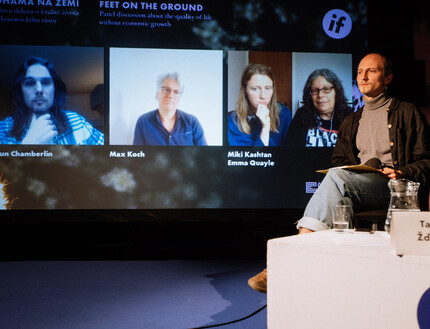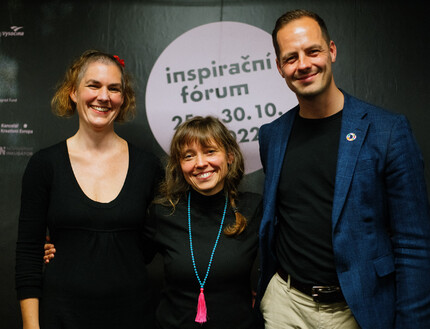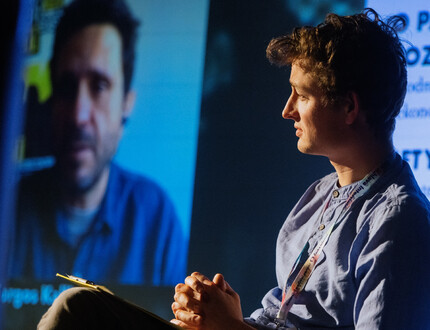Assuming the climate crisis has led to changes in society in recent years, the ongoing political crisis triggered by the epidemic and fueled by the unexpected and devastating war in Ukraine is driving society into a spiral of inflation and unpredictability. After years of relative calm now comes a period of uncertainty. In many aspects of economic and political life, we seem to be reaching our limits, which we’ve refused to acknowledge for so long. All this will, in turn, have a radical impact on the film industry, which has so far held on to the standards of the industry boom, whether it’s through changes in the habits of impoverished moviegoers who provided box office income in the years before the pandemic, or increasing production costs that will affect the entire sector. Moreover, the film industry is all the more vulnerable because it’s very closely linked to the grant cultural policy, which, faced with rising health care and education costs, among other expenses, will hardly be able to keep up with inflation and increase the available allocations in grant programs across European, state, and local institutions. If we look at the whole production chain, we can see that the problem will already begin in the input phase – that is, in the production of audiovisual works. But more fundamentally, the output – or rather, their presentation – will be affected, which may destabilize the system in the long run. However, the most affected might be independent filmmaking, which we perceive as the top segment of the entire audiovisual industry. That’s why it’s worth considering how we can fundamentally transform the audiovisual landscape so that it can adapt to the new environment and be preserved in as diverse a form as possible.
Degrowth as a way out?
Many philosophers and economists see the limits of industry, technological progress, and other aspects of modernity as an opportunity to find alternatives. Previously, these limits were examined within the context of sustainable development, which is partly linked to the degrowth approach. In addition to reducing unnecessary consumption and production and reducing their ecological footprints, the degrowth movement encourages the redistribution of resources and the strengthening of communities and local relationships. Degrowth rejects GDP as a standard indicator of “quality of life,” because its calculations fail to include negative externalities, i.e. economic profit at the expense of the environment and people.
We also have a habit of framing the audiovisual industry through economic growth-oriented indicators, such as the number of viewers, subscribers, accreditations, the size of the budget, and perhaps even reach. In the last two years since the onset of the pandemic, however, we were forced to realize how fragile the cultural sphere is. In the absence of audiences, cultural production suddenly seemed unnecessary. While audiovisual productions were the only things we could consume on the internet while in lockdown, live culture turned only to closed working groups of its auteurs and their related professions. It slowly began to feel like a return to the post-pandemic reality would be met with a slowdown and taming of overproduction.
The argument about the legitimacy of cultural subsidies is now more than ever based on concepts such as incentives, investment, the multiplier effect, returns on investment, and also the growth of small and medium-sized enterprises, etc.
After lockdowns were over and restrictions for visiting cultural institutions came to an end, a remarkable moment came. Projects that had accumulated over this period had to be released in order for producers to meet the conditions for receiving a grant. Theatre seasons doubled, independent ensembles reprised old pieces and premiered new ones at the same time, one Czech film after another was released in cinemas, and musical promoters were catching up on cancelled tours. It was in this atmosphere that the Open Letter to the New Minister of Culture1) was created not only at the HaDivadlo Theatre in Brno. The letter became a manifesto for linking the degrowth discourse as we knew it from economics and environmentalism with the creative industry, and it was signed by dozens of artists and cultural workers. Above all, it calls for the stabilization, relaxation, and abandonment of the economic terminology that dominates the (primarily political) debate on the benefits of creative industries. The argument about the legitimacy of cultural subsidies is now more than ever based on concepts such as incentives, investment, the multiplier effect, returns on investment, and also the growth of small and medium-sized enterprises, etc. So should we turn away from the film industry in favor of filmmaking? How could we now measure the meaningfulness and performance of the film industry and the entire audiovisual industry?
Can creative industries be considered growth- or degrowth-based?
The topic of degrowth in the audiovisual industry or in cinema has not yet been explored in detail. Its reflection is primarily limited to dealing with climate change through “Planet Placement” – i.e. inserting educational messages and links into the content of works, or green filming1) – tools such as waste sorting or reducing the carbon footprint during production. However, there’s also a study that goes beyond these topics and tries to find ways to stop the overproduction that has been triggered worldwide by the digitization of film. Its author Maria Antonia Velez Serna is radical in her contributions. She makes references to the “pre-digital” era when the physical filmstrip acted as a natural barrier to high-speed distribution. A film gradually made its way into the cinema network and cycled through it for several months. Nowadays, this process is happening in a matter of days, weekends, or a few weeks max. At the same time, the unavailability of audiovisual content aside from cinemas and TV syndication has enabled films to be extracted much more intensively than they are today. In both cases, we can agree with her. It is truly alarming that such a financially demanding work as a feature-length film has such a short lifespan. While many productions made before the Fall of the Berlin Wall are still available to us, films that were made after 1989 are rarely seen again. The idea of going to the cinema several times in a row seems quite absurd today. Perhaps only the older generation is still willing to see a film in the cinema and then on their home screens, or to return to the timeless classics that TV syndication supplies us with throughout the summer. Audiovisual works are so accessible these days that we can feed our desire to watch them with new stimuli whenever and wherever we want with just the flick of our thumbs.
However, if one Czech distributor or film festival decides, as HaDivadlo2) did, that this season they will not come up with any new productions and will only play what they’ve already played before, then they’ll lose to the fierce competition that exists on the market – regardless of the amount of public funds the market consumes. It will be the last gesture this private enterprise will make. The question also arises as to which segment to cancel or limit? Should we stop filming comedies, or should we stop making arthouse films? Will this be resolved by the market itself or by cutting back on state support, which is awarded across the European countries? Will it be a natural change, or will we have to take some measures?
Degrowth in the film industry cannot be approached simply by cutting the costs of distribution and limiting the carbon footprint of filmmakers and viewers.
Another aspect mentioned by the author is the future of cinemas and watching films as a shared experience. Here, too, she’s radical and says that brick-and-mortar institutions are too expensive, and the institution of cinema needs to be moved to living rooms, schools, or pubs. But the cinema is not just about meeting and having a shared experience, it’s also about social status, and the film viewer is not just a viewer of art films, but also a viewer of blockbusters who’s probably not happy with watching them in their living room. And it’s also clear that there’s usually no money involved in living rooms for creators and production teams, so this step could only take place if we consciously decide that audiovisual production becomes an amateur hobby that affects only the immediate surroundings of its creators. Degrowth in the film industry cannot be approached simply by cutting the costs of distribution and limiting the carbon footprint of filmmakers and viewers. For us, that would mean giving up on the notion that we have plenty of resources at our disposal that we can learn to deal with better and more effectively.
Degrowth targets and public money
An important motive that revolves around the notion of degrowth is the level, or rather the differentiation, of the discussions that are being held about the economy of culture. In the broader social and political debate, we are still sliding more along the dialectical line, whether to perceive culture as a superstructure or the basis of society, and whether it should be transformed by the influence of state politics or rely on the favor of the market. The reality is, it works both ways. Commercial projects are created (mainly midstream romantic comedies for cinemas or the entire segment of TV series in the audiovisual industry) and, in addition, there’s a parallel segment of authorial works (film d'auteur, documentaries, animations). At the same time, public support is directed to all segments. Both infrastructure (theatres, cinemas, galleries, festivals) and content creation are supported. In the political debate, culture sometimes shakes in ideological battles over who wastes more of the public funds and who wastes on unnecessary goods in times of crisis. Why should it be wrong to hold an expert and political discussion on the defense of subsidies and incentives to culture using concepts such as the appreciation of resources invested (including in relation to human capital) or the growth of creative industries, etc., as suggested by the aforementioned open letter? Does it really create this unbearable pressure?
Degrowth is not based on external circumstances, but on a voluntary decision. The point is to find a meaningful path and preserve what is most important in our system.
The primary means of sustainable development or even degrowth in the audiovisual sector (which represents the end of the precarization of work in the sector, the disappearance of pressure caused by overproduction, and the “greening” of production and marketing) is the debate on the direction of public support. It’s essential to think carefully about what the conditions will be and what projects such support will contribute to. So far, it seems that public funds in culture are there so that the entire sector doesn’t collapse, but maybe it’s time to think about how to zero in on these funds to help the sector meet its crucial targets. It’s above all the preservation of a free space for creation, preservation, and the development of human capacities and competitiveness towards foreign countries, because the Czech audiovisual sector and, consequently, Czech culture cannot do without contact with the outside world. Today, public officials and politicians are not the ones directing public support towards culture. They only create administrative frameworks and negotiate allocations. The actual redistribution and conceptual work lies with professional organizations. The revision of existing grant systems in the whole cultural field (including subsidies for the operation of public-benefit organizations) is therefore an important prerequisite for us to come up with a new comprehensive cultural policy that naturally must reflect both the limited resources of public and private finances and the limited natural and human resources. A policy that will mark the end of a series of sets, teams, institutions, and events that will no longer be able to be kept alive with the allocations but will be a long-term guarantor for the development of those who will be able to cope with the funds.
The Czech debate, represented by the aforementioned letter addressed to the Minister of Culture, calls mainly for better working conditions, which in this form, cannot be financed by degrowth that is, in turn, represented by a communal and shared way of life. So it’s calling for massive state intervention, but it must be driven by a stable system and available resources, which are scarce on all fronts. With the pre-Covid allocation of public funds to film production and distribution, including festivals, we will inevitably suffer from a decline in resources. Degrowth, however, is not based on external circumstances, but on a voluntary decision. The point is to find a meaningful path and preserve what is most important in our system – regardless of whether we think about film (culture) in economic or aesthetic terms.
The text was originally published in the 2021 Ji.hlava IDFF festival book.
---
Notes
2) Ze závěrečného zhodnocení divadelní sezóny, která měla podtitul nerůst, však vyplývá, že šlo jen o časově ohraničený experiment a že se divadlo v nastávající sezóně vrací k tradičnímu dramaturgickému plánování a produkční praxi. See









